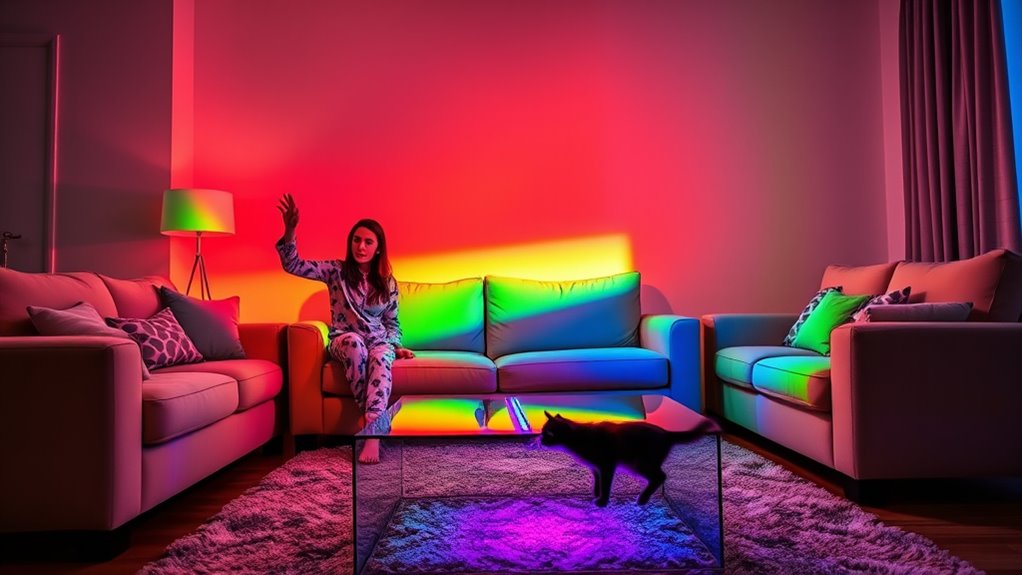Smart lights can sometimes act up, turning your home into a comedy or even a haunted house. Unexpected color changes, voice command mishaps, or firmware glitches may cause flickering, rainbow flashes, or lights following you around. Naming rooms oddly or electrical surges can make things worse. To avoid these funny fails, keep firmware updated, calibrate your system, and choose clear labels. Curious how to prevent more of these light mishaps? Keep exploring for expert tips.
Key Takeaways
- Keep firmware updated and calibrate lights regularly to prevent unexpected color changes and glitches.
- Use unique, descriptive room names to avoid triggering unintended scenes or routines.
- Install surge protectors and check wiring to prevent flickering caused by electrical surges.
- Adjust sensor sensitivity and review automation schedules to reduce accidental activations or flickering.
- Understand your lighting system’s controls and troubleshoot firmware or connectivity issues promptly to minimize surprises.
When Your Lights Suddenly Turn Neon Pink During a Dinner Party

If your smart lights suddenly turn neon pink in the middle of a dinner party, it can be startling and disruptive. You might wonder if you accidentally changed the lighting or if there’s a technical glitch. To prevent such surprises, stick to good lighting etiquette by choosing warm, inviting colors that suit the occasion. This not only creates a cozy atmosphere but also shows respect for your guests. Additionally, pay attention to energy efficiency settings; some smart lighting apps allow you to optimize brightness and color without wasting power. Regularly updating your device firmware and managing your lighting schedules can help avoid unpredictable color changes. Being aware of lighting control technology can help you better understand and troubleshoot your smart lights. Staying proactive guarantees your dinner stays elegant, while your smart lights remain a helpful, energy-efficient addition to your home.
The Time a Voice Command Made the Lights Flash in Morse Code
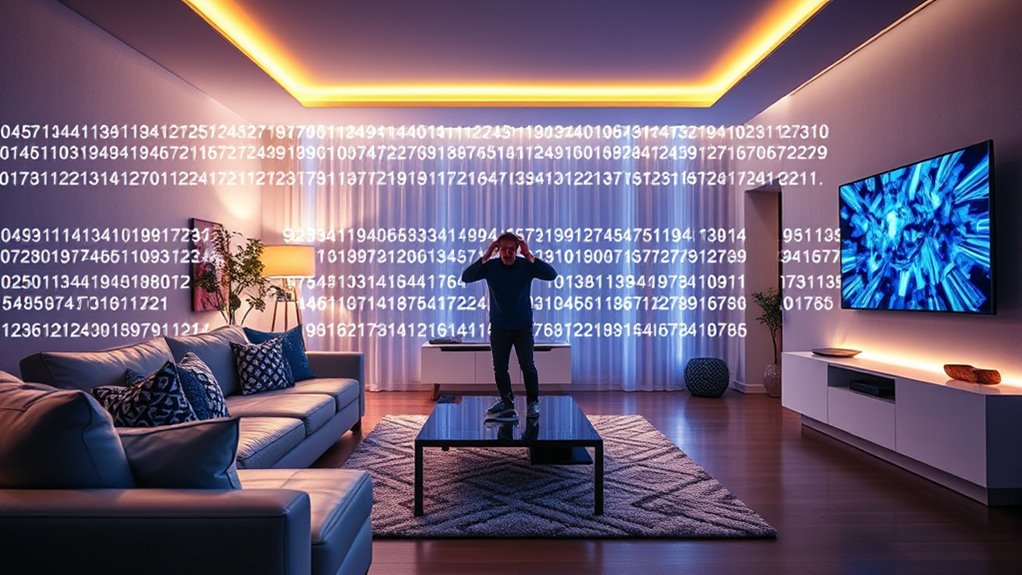
One unexpected moment with smart lights occurred when a simple voice command caused them to flash in Morse code, turning a routine evening into a quirky experience. It all started with a voice command that was misunderstood due to voice command errors. Instead of turning on the lights, your smart system began flashing in Morse code lighting, sending messages you didn’t intend. Here’s what happened:
- Miscommunication caused the system to interpret your command incorrectly
- The lights started blinking in Morse code, creating a confusing pattern
- You and your guests watched in surprise, wondering what message was being sent
- It took a few moments to reset the system and stop the Morse code lighting
- This incident illustrates how sound design and system feedback play crucial roles in smart home technology to prevent such humorous mishaps.
This funny mishap highlights how voice command errors can lead to unexpected, hilarious smart light fails.
How a Firmware Glitch Turned Your Bedroom Into a Disco Scene
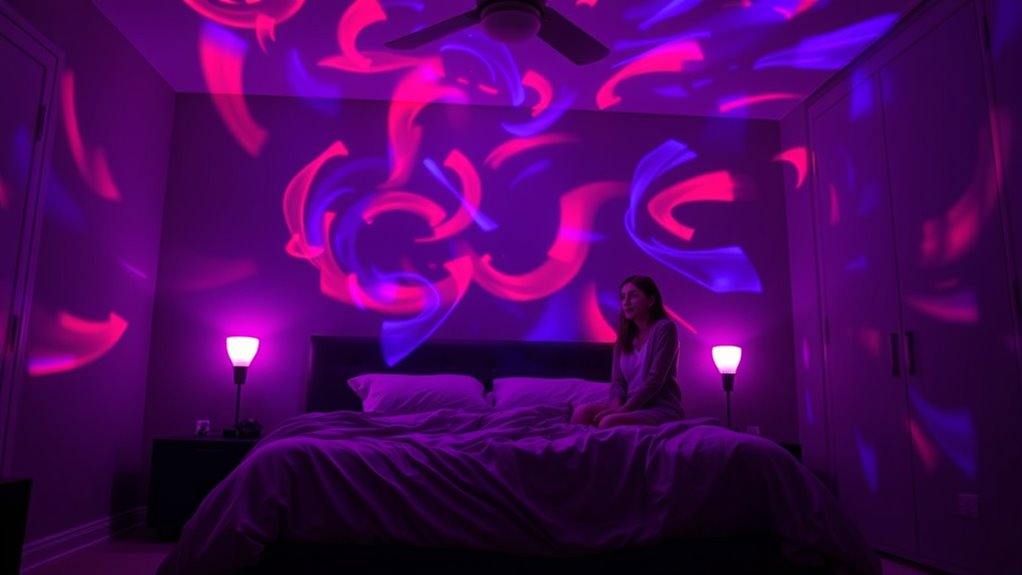
One firmware glitch can cause your smart lights to change colors unexpectedly, turning your bedroom into a flashing disco. You might notice syncing issues where lights flicker out of sync or respond slowly. Sometimes, a simple firmware update mishap makes your lights behave wildly, creating a chaotic lighting show.
Unexpected Color Changes
A firmware glitch can cause your smart lights to behave unpredictably, turning a simple bedroom into a flashing disco scene without warning. Unexpected color changes often stem from issues like improper color calibration or hardware compatibility problems. These glitches can make your lights shift to wild hues or flicker erratically. To prevent this, consider these tips:
- Regularly update firmware to fix known bugs.
- Ensure your lights are compatible with your hub or app.
- Calibrate colors correctly during setup.
- Avoid mixing different brands or models that might conflict.
- Using vetted home theatre projectors can help ensure your entire entertainment setup remains consistent and glitch-free.
Syncing Malfunctions Occur
When your smart lights suddenly flicker or change colors unpredictably during a sync attempt, a firmware glitch is often to blame. This can turn an otherwise smooth setup into a chaotic disco scene. To regain control, use the manual override feature to pause or reset the process. Sometimes, the firmware mismatch causes synchronization issues, making your lights behave erratically. Remember, user customization options can help you adjust settings and prevent future malfunctions. If the sync fails repeatedly, uninstalling and reinstalling the app or firmware update might be necessary, but avoid rushing into updates that could introduce new bugs. Ultimately, staying patient and leveraging manual controls ensures you maintain command over your lighting system, avoiding unintended light shows and keeping your bedroom calm and cozy. Regularly checking for firmware updates can help prevent such glitches from occurring.
Firmware Update Mishaps
Firmware glitches during updates can unexpectedly turn your calm bedroom into a flashing dance floor. When a firmware glitch occurs, it can disrupt your smart lights’ settings, often resetting user customization and raising security concerns. To avoid these mishaps:
- Always back up your settings before updating.
- Keep your device firmware updated regularly to fix bugs.
- Use reliable Wi-Fi connections to prevent incomplete downloads.
- Read update notes to understand new features and potential risks.
These precautions help maintain security and preserve your preferred lighting schemes. Skipping steps or rushing updates can lead to unexpected flickering or color chaos, turning your space into a disco scene. Staying cautious ensures your smart lighting remains safe, personalized, and glitch-free.
The Great Color Mix-Up: When Your Living Room Becomes a Rainbow
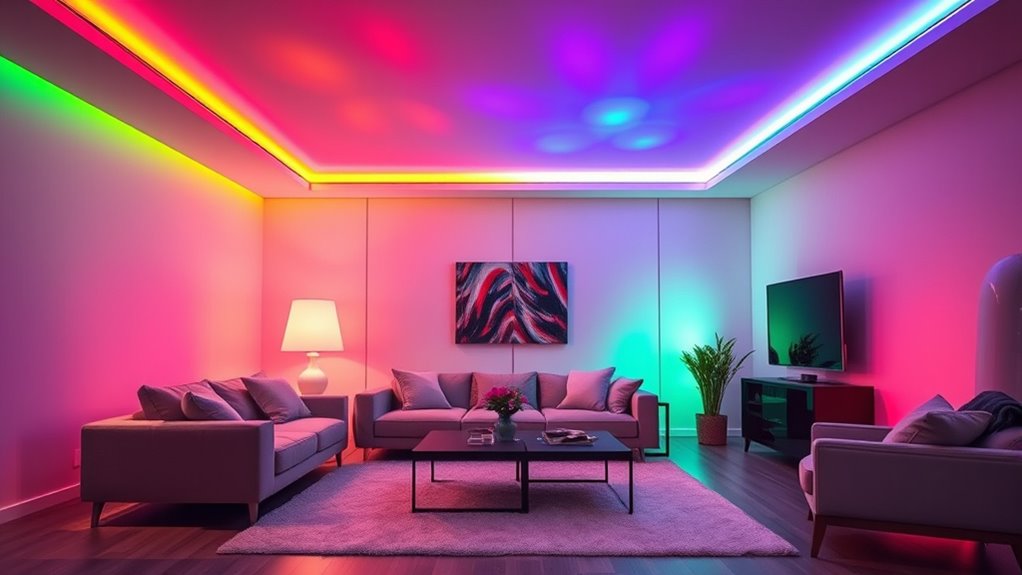
If your smart lights suddenly start flashing a rainbow of colors without warning, it can quickly turn your cozy living room into a chaotic spectacle. This color mix-up disrupts your lighting aesthetics, making it hard to set a calm or inviting mood. You might have accidentally triggered a preset mode or an app glitch, causing the lights to cycle through colors unpredictably. Understanding color psychology helps you choose the right hues for relaxation or focus, but these unexpected changes can undermine that intention. To avoid this, double-check your app settings, disable automatic color-changing modes, and ensure your firmware is up to date. Keeping control over your smart lighting prevents accidental rainbow displays and preserves the atmosphere you want to create. Necessary cookies help ensure your device maintains proper connection and functionality, reducing the chances of glitches causing unexpected color changes.
The Day Your Smart Lights Mistook Your Cat for a Guest
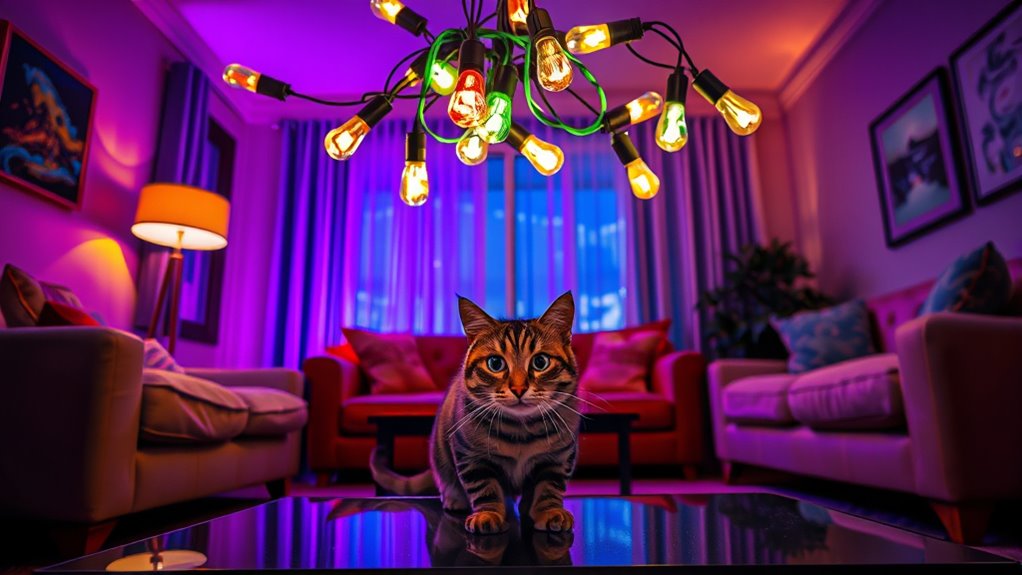
One day, your smart lights suddenly flooded the room with a welcoming glow, mistaking your curious cat for a guest entering through the door. Thanks to voice recognition quirks, the system thought it detected a person and turned on the lights automatically. The result? Your feline friend was bathed in bright, unnecessary illumination, causing confusion and a dash of humor. To prevent this:
- Adjust voice recognition sensitivity so it’s less likely to mistake pets for humans.
- Use pet-friendly routines that ignore small movements or sounds.
- Enable energy efficiency settings to automatically dim lights when no human presence is confirmed.
- Regularly update firmware to improve detection accuracy and avoid false triggers.
- Understanding smart home technology helps you optimize your system’s settings and reduce errors.
When a Routine Update Turns All Lights Off Instead of Dimming
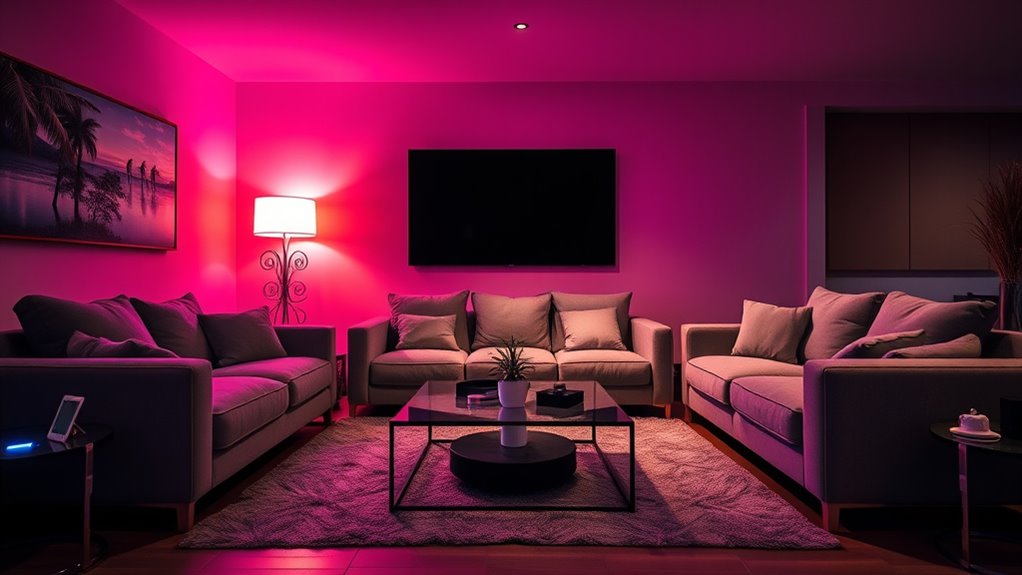
Sometimes, after updating your smart lights, they unexpectedly turn all the lights off instead of dimming as intended. This glitch is often related to lighting automation settings or recent firmware changes that reset default behaviors. You might have configured your lights for smooth dimming during certain hours, but the update disrupted this user customization. To fix this, double-check your automation rules and ensure the dimming settings are still active. Some updates reset preferences to factory defaults, so reconfigure your preferred lighting levels. Keep in mind that updates sometimes cause temporary bugs, so testing your lighting automation after updates can prevent surprises. Staying vigilant about your settings helps maintain consistent control and avoids the frustration of a complete blackout whenever you expect a gentle dim.
The Unexpected Consequences of Naming Your Rooms “Party” and “Chill”
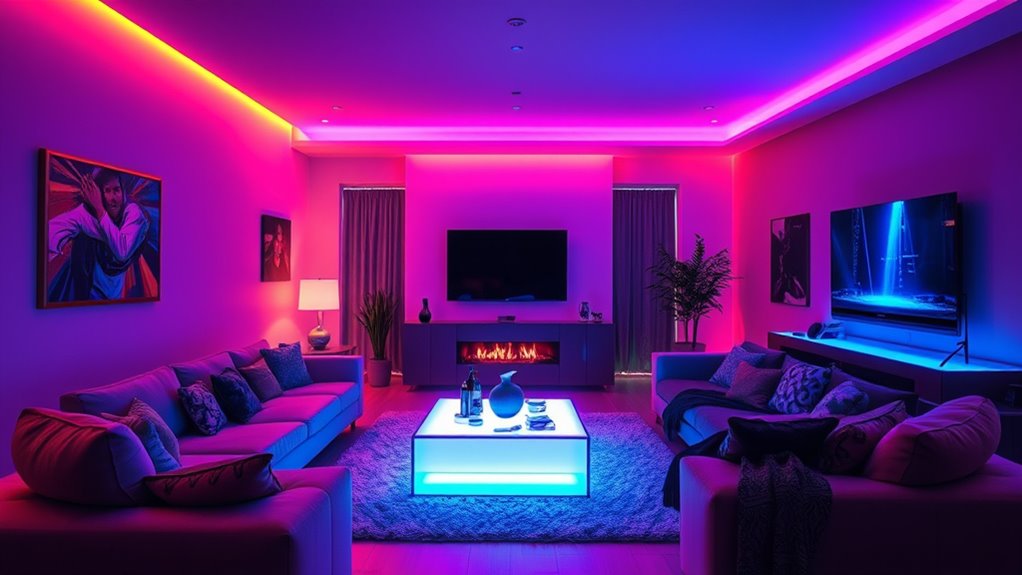
Naming your rooms “Party” and “Chill” can lead to unexpected automation issues because smart lighting systems often interpret these labels as specific commands or scenes. This confusion can cause your lights to behave unexpectedly. Here are some pitfalls to watch out for:
Using generic room names like “Party” or “Chill” can cause your smart lights to misfire or activate unintended scenes.
- Lighting labels may trigger scenes unintentionally, turning on disco lights in the “Chill” room.
- Automation routines might activate when you enter the “Party” room, even if you just want a relaxing evening.
- Voice commands referencing “Party” or “Chill” could activate unintended lighting scenes.
- Overly generic room naming can cause your system to misinterpret your intentions, leading to confusing light behavior.
- Using descriptive, unique names aligned with room function helps prevent lighting label mishaps and keeps your smart home running smoothly.
How a Power Surge Made Your Lights Blink Like a Haunted House
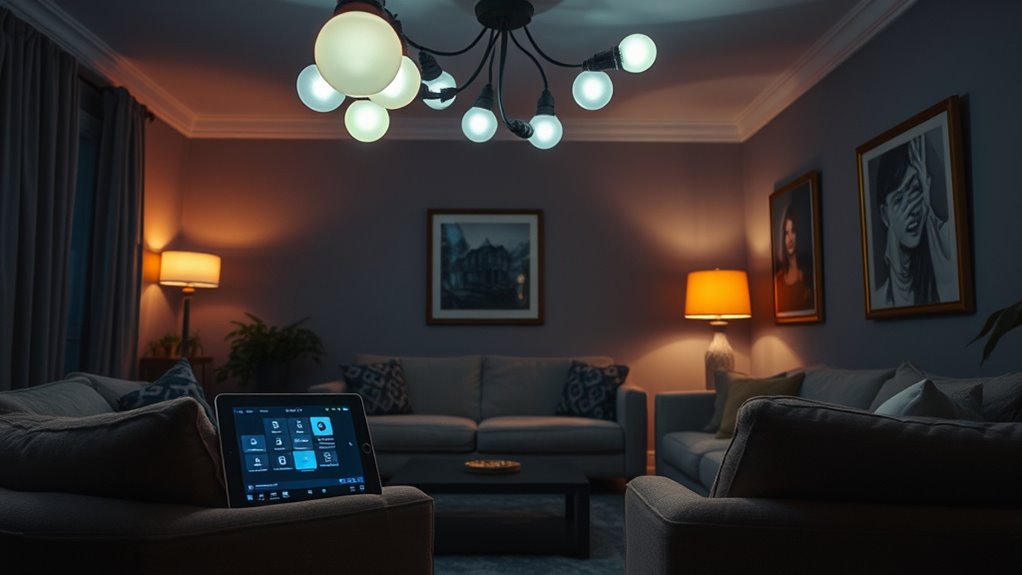
A sudden power surge can turn your normally steady smart lights into a flickering, haunted house spectacle. When a power surge occurs, it overloads your electrical system, causing your smart lights to blink uncontrollably. You might think your lights are possessed as they flicker rapidly, making your home feel spooky rather than cozy. This happens because the surge temporarily disrupts the communication between your lights and their control system, triggering unintended blinking lights. To prevent this, consider installing surge protectors specifically designed for smart devices. They absorb excess voltage and shield your lighting system from sudden spikes. Regularly check your home’s wiring and avoid plugging too many devices into one outlet. Staying vigilant can save you from those eerie, blinking lights—and a potential home electrical scare. Properly maintaining your electrical system can also help prevent unexpected issues caused by power fluctuations.
The Hilarious Misfire of Automated Lighting Schedules

You’ve probably seen your lights turn on or off at the worst times, thanks to unexpected scheduling glitches. Sometimes the sensors are too sensitive, triggering lights when they shouldn’t, or room settings don’t match actual use. These misfires create some hilarious moments you won’t forget anytime soon. To prevent such issues, adjusting automation settings and ensuring proper calibration can make a significant difference.
Unexpected Light Timing
Because automated lighting schedules rely on precise timing, it’s often amusing when they go awry, leading to unexpected light timings that catch residents off guard. These surprises can disrupt your day and highlight flaws in lighting automation systems. Here’s what can cause these misfires:
- Clock Drift: Minor discrepancies in system clocks can cause lights to turn on or off at odd times.
- Schedule Overlaps: Conflicting schedules may trigger unexpected lighting, especially if color calibration isn’t consistent.
- Power Interruptions: Sudden outages reset timers, making lights turn on or off unexpectedly.
- Software Bugs: Glitches in the automation software can cause unpredictable timings, often with mismatched colors or brightness levels.
To prevent this, regularly update your lighting automation software and check color calibration for seamless operation.
Overly Sensitive Sensors
Overly sensitive sensors can turn your smart lighting system into a comedy of errors, triggering lights at the slightest motion or false alarms. Motion sensors are designed to detect movement, but when they’re too sensitive, they may activate lights unnecessarily, even from passing shadows or pets. This can lead to brightness issues, where lights flicker or stay on when they shouldn’t. You might find yourself stumbling in a dark room because the sensor thought you moved, or facing constant dimming and brightening cycles. To avoid this, adjust the sensor’s sensitivity settings or reposition them to minimize false triggers. Proper calibration guarantees your lights only turn on when needed, preventing those hilarious misfires and giving you a more reliable, frustration-free experience. Additionally, selecting appropriate sensor types can help ensure your lighting system responds accurately without overreacting to minor movements.
Mismatched Room Settings
Mismatched room settings can turn your smart lighting into a source of constant confusion, as automated schedules don’t always align with how you use each space. To prevent these mishaps:
- Use manual override during special occasions or unexpected needs to bypass schedules.
- Adjust light color calibration to match the room’s purpose, like warmer tones for relaxation.
- Set different schedules for each room, considering natural light and activity patterns.
- Regularly review and update your lighting routines to prevent misfires and ensure the right ambiance.
When a Firmware Bug Caused Your Lights to Follow You Around the House
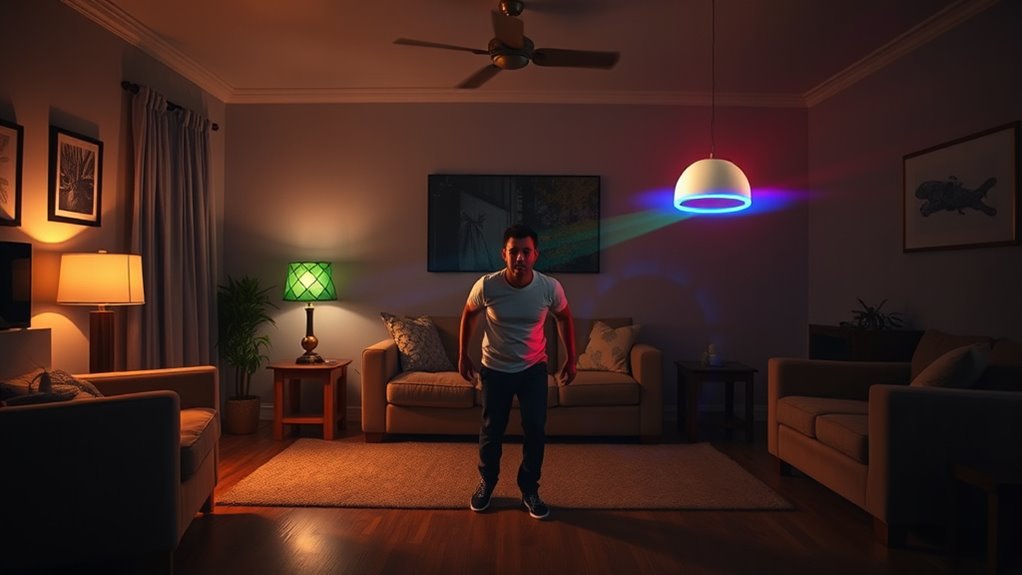
A firmware bug can turn your smart lights into an unexpected nuisance, causing them to follow you around the house instead of staying put. Firmware quirks sometimes disrupt the user interface, making your lights unpredictable. You might find them flickering, turning on unexpectedly, or moving with you as if they have a mind of their own. To fix this, start by updating your device firmware, which often resolves such glitches. Restarting the lights or resetting them to factory settings can also help. Remember, staying aware of firmware updates prevents future surprises. Below is a quick guide to common issues:
| Issue | Cause | Solution |
|---|---|---|
| Lights follow you | Firmware quirks | Update firmware |
| Unexpected flickering | User interface glitches | Reset device |
| Lights turning on/off | Software bugs | Reinstall app or firmware |
Frequently Asked Questions
Can Smart Light Malfunctions Cause Electrical Damage?
Smart light malfunctions can sometimes lead to electrical damage, especially if there’s a power surge or faulty wiring. These issues pose safety concerns, like the risk of electrical fires or short circuits. To prevent such problems, you should guarantee your smart lights are properly installed, use compatible devices, and regularly update firmware. Staying vigilant helps you avoid electrical damage and keeps your home safe from potential hazards.
How Do I Reset My Smart Lights After a Glitch?
If your smart lights glitch, start by unplugging and plugging them back in. For voice command errors, try resetting the device via the app’s reset option or power cycle. Check for firmware updates, as outdated software can cause glitches. Sometimes, a factory reset is needed—follow the manufacturer’s instructions, usually involving a button press. This clears errors and restores proper function, helping you avoid future issues.
Are There Safety Risks With DIY Smart Light Fixes?
When you consider DIY fixes for your smart lights, be aware of DIY hazards and electrical safety risks. If you’re not confident, you might accidentally cause a short circuit or damage the device, leading to potential fire hazards. Always unplug the lights first, use insulated tools, and follow instructions carefully. If unsure, it’s safer to consult a professional electrician to avoid accidents and ensure your smart lighting remains safe and functional.
What’S the Best Way to Prevent Accidental Color Changes?
Did you know 65% of smart light users experience accidental color changes? To prevent this, implement automation tips like setting specific schedules and using scene presets. Regularly check and calibrate your lights for accurate color calibration. Lock your app settings or disable certain controls when not in use. These simple steps help keep your lighting just the way you want, avoiding unexpected color shifts and ensuring a smooth, enjoyable experience every time.
Can Smart Light Errors Affect Other Smart Home Devices?
Smart light errors can indeed affect other smart home devices, especially if they’re linked through voice control or app compatibility. If your smart lights glitch or disconnect, your voice commands might misfire, impacting devices like smart speakers or thermostats. To prevent this, make certain your apps are up-to-date and your devices are properly integrated. Regularly check for firmware updates and troubleshoot connectivity issues to keep your entire smart home running smoothly.
Conclusion
Smart lights can be hilarious when they go wrong, but with a little caution, you can prevent most mishaps. Don’t get discouraged—technology isn’t perfect, and glitches happen. Just stay patient, double-check your settings, and keep firmware updated. Remember, these quirks add humor to your smart home journey. With a few simple tips, you’ll enjoy the convenience without the chaos, turning your smart lighting into a true home upgrade, not a comedy show.
